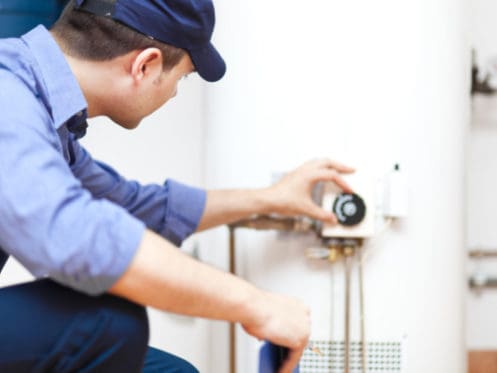If you own a traditional gas or electric water heater, it is always a good idea to have the tank flushed out at least once a year. Tankless water heaters don’t ever need to be flushed since they don’t store any water, but traditional units will always benefit from a yearly flushing. To understand why, here is a full overview of why water heaters need to be flushed and what benefits flushing provides.
How to Flush a Water Heater and Why It’s Necessary
Flushing a water heater is one of the most important maintenance tasks. It involves first draining the tank and then running cold water through it to flush all of the sediment out of the tank. The water that comes into your house always contains some dissolved minerals and impurities. As the water inside the tank is heated, some of these minerals will harden and form sediment that settles to the bottom of the tank. Areas with hard water have a much higher concentration of minerals and this result in the sediment forming and building up inside the tank more quickly.
All of the sediment inside the tank can negatively impact the unit’s performance. Sediment is also one of the primary reasons that water heaters fail. Flushing the tank every year prevents too much sediment from building up to ensure that your water heater can continue working effectively. While flushing is something that you can do on your own, it is always easiest to have a plumber do it for you as part of your annual water heater maintenance service. The main reason for this is that the plumber will always need to drain the water heater in order to inspect it, so it only makes sense that they would also flush the unit at the same time.
The first step to flushing a water heater is to turn the unit off so that the water inside the tank has plenty of time to cool down. Attempting to flush the tank before it has time to cool carries a huge risk of scalding and is never recommended. To prevent this risk, the unit should always be turned off at least a few hours before flushing. Even better is if you can shut it off the night before you plan to have it flushed.
Once the water has sufficiently cooled, the water supply to the unit is then shut off. After attaching a garden hose to the drain valve, the majority of the water is then drained from the tank. In order for the tank to drain properly, it is necessary to leave at least one faucet open with hot water running. If all of the faucets are closed, it can cause a vacuum to form inside the tank and prevent any water from draining out.
After draining the tank, the cold water supply is turned back on so that the tank can now be flushed. The water is then left to continually run through the unit until the water coming out of the tank is completely clear and no more sediment is coming out. The tank usually needs to be flushed for 15 to 20 minutes, but it could take up to an hour if there is a lot of sediment.
If you don’t have your tank flushed yearly, all of the sediment will often end up clogging the drain valve when you do finally have it flushed. If the valve is seriously clogged, often the only way to clear it is by hooking up the other end of the hose to a water supply and backflushing the tank. This is generally not something you should try on your own, which is another reason why it is usually best to hire a plumber to flush the unit for you. If the valve is completely clogged, it may be necessary to replace it and this is also not something you can easily do on your own.
Now that you know how flushing works and why it’s necessary, let’s take a closer look at the different benefits that it will provide.
Longer Lifespan and Fewer Repair Needs
The biggest benefit of flushing your water heater annually is that it will help to increase the unit’s lifespan. Gas water heaters will typically last for somewhere between eight and 12 years, while the average life expectancy of electric water heaters is around 10 to 15 years. These life expectancies are assuming that you have the unit drained, flushed and professionally inspected and maintained yearly. If you neglect any of these important maintenance tasks, the water heater will often only last for five years or so.
Neglecting to have your water heater flushed annually will lead to more sediment building up inside the tank and start to hamper its performance. Sediment build-up will decrease the unit’s efficiency and result in it needing to heat more frequently and running for a longer period each time it heats. This will lead to greater wear and tear and often cause the unit to break down and need to be repaired more frequently.
In gas water heaters, sediment build-up often leads to hot spots forming at the bottom of the tank whenever the unit is heating. This can weaken the tank and potentially cause it to corrode more quickly and start leaking. With electric water heaters, sediment build-up can damage the lower heating element and cause it to fail and need replacing.
Improved Energy Efficiency
Flushing your water heater regularly ensures that sediment doesn’t interfere with its performance. This means that the unit will heat more effectively and run for shorter times. As a result, the unit’s energy costs will be far lower if you flush it every year. If you don’t flush the tank, all of the sediment will act as an insulator and capture much of the heat preventing it from being transferred to the water, and this will reduce the unit’s energy efficiency.
Shorter Recovery Time
Recovery time refers to how long it takes for the water heater to fully reheat after you have used up all of the hot water in its tank. Typical recovery times are usually somewhere between 30 minutes and two hours depending on the type of unit (gas or electric) and the size of the tank. If you don’t have your water heater flushed, the reduced efficiency due to the sediment will often cause the recovery time to double or even triple.
Quieter Operation
Older water heaters are often prone to making loud knocking or banging noises whenever they are heating, and these noises are directly related to sediment build-up. If you ever hear your water heater making these noises, it is a sure sign that you need to have it flushed.
Whenever the unit is heating it produces lots of tiny air bubbles that rise to the top of the tank. These air bubbles will float up through the sediment, and this can disturb the sediment and cause pieces of it to bang against the sides of the tank. Flushing the tank regularly minimizes the sediment to prevent this issue from occurring.
At First Choice Plumbing, Heating & Air Conditioning, we specialize in water heater repairs and maintenance and can help ensure your unit is working effectively for years to come. We can also help with water heater replacement, and we install both traditional and tankless units for residential customers in Metuchen and the surrounding areas. Our licensed plumbers also install and repair most all other plumbing appliances and fixtures. If you need any heating or cooling repair, installation or maintenance services, we have a team of certified HVAC technicians to help with that as well. Give us a call today to schedule a time to have your water heater maintained and inspected or if you need any other plumbing or HVAC service.



